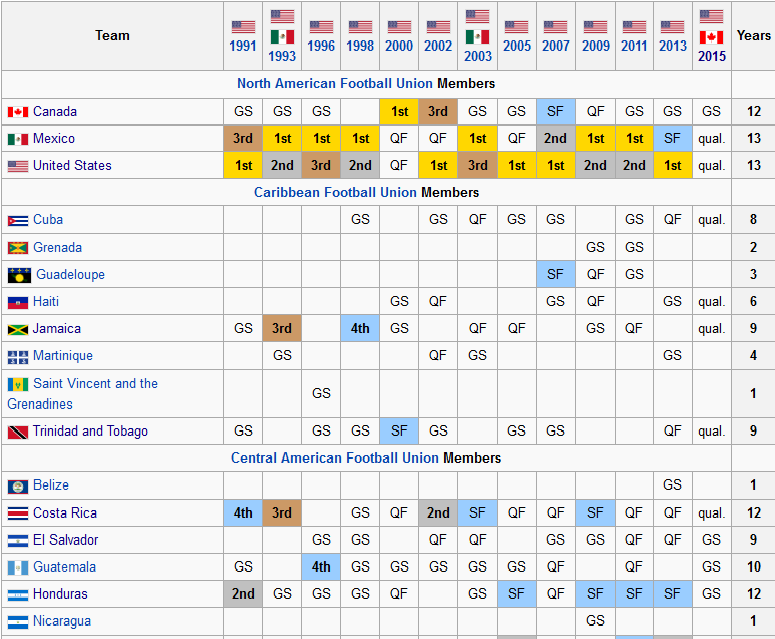
Jamaica sits atop Group B, Trinidad and Tobago the same in Group C. Two group winners and with Cuba and Haiti qualifying too, the Caribbean zone enter the quarterfinals intact. The victims, Central America, as Guatemala, El Salvador, and Honduras fell by the wayside. Costa Rica qualified but were unconvincing and without a win, Panama scraped through on the best of a third place finish.
In fact, the Central Americans finished the group stage without recording a single win compared to the Caribbean contingent’s 6 victories. And it wasn’t just them left to ponder questions. Up north, there wasn’t a lot of comfort to be found either.
CONCACAF giants Mexico endured a torrid time at the hands of the Soca Warriors failing to secure first place. The USA, regional behemoths themselves were pushed to the limits by Haiti before Clint Dempsey secured the winner. Canada as co-hosts endured a miserable tournament, exiting without even scoring a goal.

This isn’t an anomaly. The Caribbeans played bright, attacking soccer, showing impressive technicality and boundless athleticism. Defense, their usual Trojan horse, is still a work in progress but much improved. The Central Americans regularly send teams into the quarterfinals. In 2013, all of them sailed into the quarter-finals save Belize. Panama went to the finals losing to the USA and Honduras made it the semi-finals. The 2011 edition, saw all the Central Americans make it to the quarterfinals with Panama and Honduras going a level further. As the table above shows, this is the first time the Caribbean nations have reached the quarter-finals unscathed. It’s quite remarkable.
Part of the reason is the Caribbean strategy of exploiting colonial ties sending its better players to the European leagues where the overall standard is higher is paying off.
The Reggae Boyz have a big contingent represented in the Championship division, the second tier of the English league. The Soca Warriors are even more eclectic, plying their trade in far flung leagues: Scandinavia, Eastern Europe, Asia, and closer to home, their own league, the MLS, and even Central America. Haiti’s side is exclusively offshore, a few in the USL; most including Duckens Nazon who plays for Laval in the French Ligue, in Europe.
In contrast, the Central Americans are tied to their own leagues or at most venture into the MLS. Some of the biggest stars eventually do make it to the big European leagues, for e.g., Keylor Navas to Real Madrid. More debatable, the bloody history in the region and the intense nationalism associated with soccer makes meetings between rivals a spectacle of gamesmanship and negative tactics. The game then becomes an exercise in damage control and saving face. Case in point Honduras meeting with Panama which led to 6 yellow cards, an ejection, 43 fouls, and constant jostling of El Salvador ref Marlon Mejia. The Panamanians complained of bias and their protest led to a switch in refereeing crews for their last match against USA as Joel Aguilar also of El Salvador was reassigned to the Honduras vs Haiti match which an off balance and misfiring Los Catrachos lost, as an aftermath from their emotionally and physically draining encounter against Panama.
However, Occam’s razor would say, given all the data points, the reason for improvement is the Caribbean countries are playing uninhibited and attacking soccer with eye catching performances by Jobi McAnuff, Donald-Wilde Gurriere, Keron Cummings, and Ariel Martinez backed by improved defenses and some stellar goalkeeping from the likes of Johnny Placide, Dwayne Miller and his understudy Ryan Johnson, and Marvin Phillip. Of course, the big tests which count are yet to come as USA faces Cuba, Jamaica take on Haiti in all Caribbean affair, and Trinidad and Tobago go up against Panama. One of them is assured a semi-final spot, the first time since Guadeloupe’s in 2007.